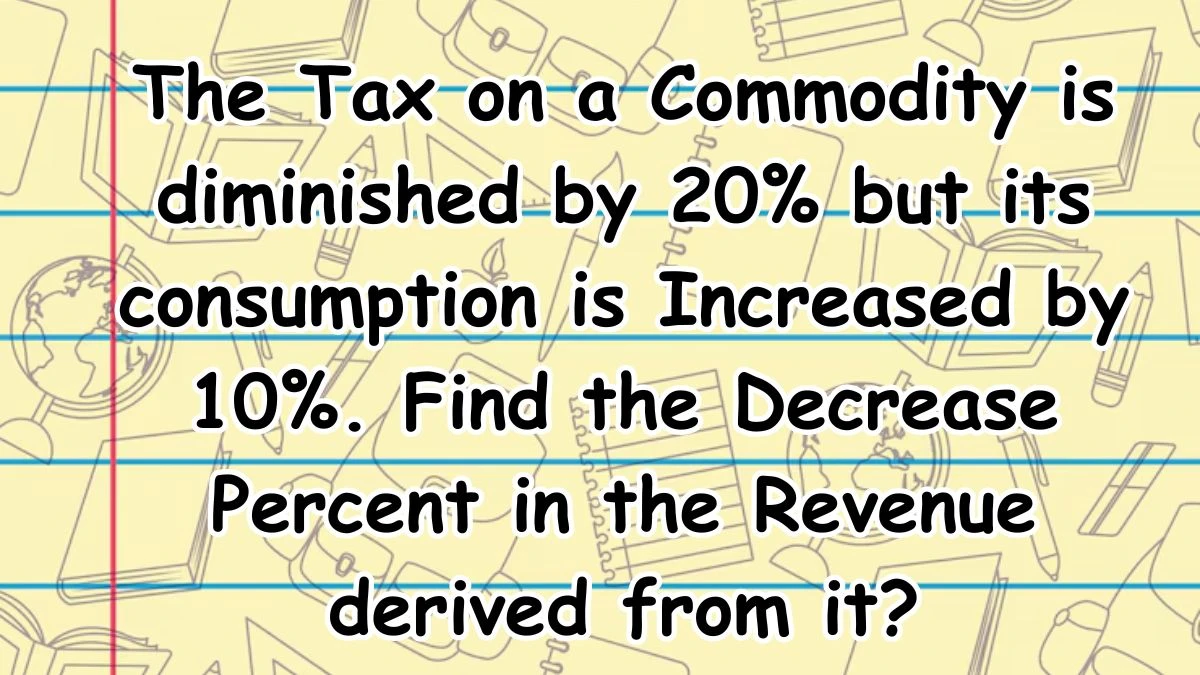The Tax on a Commodity is diminished by 20% but its consumption is Increased by 10%. Find the Decrease Percent in the Revenue derived from it?
by
Updated Jul 01, 2024

The Tax on a Commodity is diminished by 20% but its consumption is Increased by 10%. Find the Decrease Percent in the Revenue derived from it?
To determine the decrease in revenue when the tax on a commodity is diminished by 20% and its consumption is increased by 10%, use the following formula for percentage change in revenue
Percentage change in revenue = X + Y + XY/100
where,
X is the percentage change in tax
Y is the percentage change in consumption
Decrease in tax (X) = − 20%
Increase in consumption (Y) = 10%
Percentage change in revenue = − 20 + 10 + (− 20)x10/100
= − 20 + 10 − 2
= − 12
The result, -12%, indicates a decrease in revenue.
Impact of Tax and Consumption Changes on Revenue
Changes in tax rates and consumption patterns have a significant impact on revenue generation. This concept is crucial in economics and finance, helping businesses and governments understand how adjustments in pricing or taxation can influence overall earnings.
Taxation and Revenue:
Tax rates determine the amount of tax imposed on goods and services. When tax rates are increased, the cost to consumers rises, potentially reducing consumption. Conversely, lowering tax rates can make goods cheaper, encouraging higher consumption. Revenue from taxation is a product of the tax rate and the quantity of goods consumed. Any change in tax rates directly affects revenue, making it essential to understand this relationship for effective financial planning.
Consumption Patterns:
Consumption patterns refer to the way consumers purchase goods and services. Factors such as price changes, income levels, and market trends influence consumption. Increased consumption typically boosts revenue, while decreased consumption lowers it. Understanding consumer behavior helps predict how changes in prices or taxes will affect overall sales and revenue.
Combined Effects on Revenue:
To quantify the impact of simultaneous changes in tax rates and consumption, specific mathematical formulas are used. These formulas consider both the percentage change in tax rates and the percentage change in consumption to calculate the overall effect on revenue. Businesses and policymakers use these calculations to make informed decisions. For instance, a government might reduce taxes to stimulate the economy, or a company might lower prices to increase sales volume.
Economic Strategies:
Lowering taxes can be a strategy to increase consumption, especially during economic downturns. This can lead to higher overall revenue despite the reduced tax rate. Businesses might adjust prices to balance between tax rates and consumption. Understanding the elasticity of demand helps determine the optimal pricing strategy to maximize revenue.
Financial Planning:
Accurate predictions of revenue changes are essential for budgeting. Governments need to forecast tax revenue accurately to plan expenditures, while businesses rely on revenue projections to manage operations and investments. Analyzing the impact of tax and consumption changes helps in assessing the financial health of an organization or economy.




